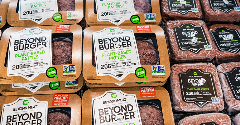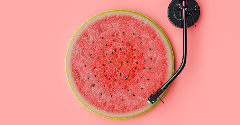sponsored content
A sticky issue: delivering superior product stability in sugar confectionery
17 Oct 2018In today’s competitive confectionery market, manufacturers are challenged to deliver new, exciting flavors that maintain stability. Ardie Lankveld, market manager at Corbion, shares factors for success

Innovation remains a strong feature of the global confectionery industry. As demonstrated by high levels of new product development and increased product launches, manufacturers are attempting to maintain consumer interest by looking for innovative ways to diversify their offering. Indeed, over the past five years, the total number of new product launches in confectionery (jellies, gummies, hard candy and sugar confectionery only), has risen steadily from 5,839 in 2010 to 7,443 in 2014. Furthermore, in geographically fragmented markets, such as Western Europe and Asia, new product innovation is particularly pronounced, while growing markets such as Latin America, the Middle East and Eastern Europe also continue to show a vast increase in product launches.
As well as experimenting with new ingredients and flavors, confectioners are increasingly reducing sugar levels and removing artificial ingredients and additives to improve the perceived health and nutritional qualities of their confectionery products. Germany-based sugar confectioner, Haribo, for example, launched a menthol gummy sweetened with stevia plant, claiming that the product has 40 percent less calories when compared with traditional licorice. Meanwhile, Italian-Dutch confectioner, Perfetti Van Melle, launched a limited edition variety of its Mentos sweet containing ‘surprise flavors’, that consumers are unable to identify as sweet or sour, fresh or fruity, until they eat it.
However, in such a competitive market, maintaining consumer loyalty is critical. Here, Ardie Lankveld, market manager – confectionery & food at Corbion, highlights some of the critical factors in developing successful new confectionery products and key considerations when formulating new recipes to meet the demands of ever-discerning consumers.
The complete package
Across the entire food and beverage industry, consumers are increasingly looking for new and extreme flavor experiences – and the confectionery market is no exception. As such, flavor innovation is a continuous trend in new product development, with many manufacturers using exotic fruits or spices, or unique sensory combinations to set their products apart, and capture and maintain consumer interest. Five fruit flavors showing impressive development in the European market include watermelon, blackcurrant, coconut, lime and cranberry, marking a significant shift away from more traditional flavor profiles such as strawberry, raspberry and vanilla. New products with flavored layers for indulgence and intense flavor editions are also making their way onto supermarket shelves.
The use of naturally-derived ingredients in food and beverage applications has also increased considerably in recent years, especially in EU, and to a lesser extent in the US, due to increasing consumer demand for clean-label, natural products and the avoidance of artificial additives. For a category in which artificial colors and flavors are prolific, this creates significant challenges for confectioners looking to create winning consumer appeal. In practice, it means they need to deliver named profiles that exhibit recognizable flavors and colors which equally impart an authentic taste, while using ingredients with ‘natural appeal’.
Meanwhile, confectionery consumers are highly discerning and intolerant of faulty products, such as those which do not meet their expectations visually (color, appearance) or in terms of taste. As such, they increasingly look for brands which consistently offer quality products that stay fresh for longer and retain their flavor and texture over time, even if the packaging had been opened. And so manufacturers need innovative ways to maintain and enhance product appearance, texture and flavor, to be able to guarantee a product’s quality throughout its shelf life.
Achieving optimal stability
Achieving optimal stability in appearance and taste in sugar confectionery is a significant challenge. Several factors, including the environment, packaging and pH can influence the overall quality of sugar confectionery. This can lead to sugar inversion in hard boiled candies, whereby the sugar splits into glucose and fructose, triggering moisture absorption, and loss of gel strength and taste impact in soft candies, such as jellies and gums.
The environment, especially in hotter climates, also has a significant impact on confectionery stability. In hard boiled candies for example, exposure to high temperatures and moisture can speed up sugar inversion, resulting in a sticky surface that is unacceptable to discerning customers. Similarly, at increased temperatures and humidity, acid sanded jellies and gums attract moisture from their surroundings much faster. This hygroscopicity results in a ‘wet’ appearance; impairing visual appeal, and causes acid to migrate from the exterior of the candy into its interior. As a result, the jellies and gums lose their instant sour taste impact, and the migrated acid might even affect the quality of the candy base.
Packaging is a common way of preserving products throughout their shelf life, by reducing their exposure to the harsh, external environment, as well as offering protection from micro-organisms and damage. The right packaging material and seal integrity are imperative in ensuring an effective barrier against these external influences. In an attempt to overcome the most difficult issues, manufacturers have experimented with thicker packaging materials or placed smaller bags within an outer package. However, these solutions can significantly increase cost and are considered detrimental to the environment.
In confectionery, sourness has always been used as a basic taste component to offset the otherwise intense sweetness of sugar. So as consumers turn toward more new and exciting flavor combinations, including intense sourness, achieving the perfect flavor profile has become a significant challenge for manufacturers. As a result, acidulants, particularly citric acid, are widely used across the industry to improve flavor profiles by reproducing authentic flavor reminiscent of real fruit. Finding a stable sugar-acidulant matrix, however, is difficult. This is because adding an acidulant often impacts overall product quality and texture stability in confectionery products.
Finding the perfect formulation
A fruit-flavored candy formulation without an acid has a pH of around 6 or 7, and tastes extremely sweet. In order to create a fresh or intensely sour taste, an acid must be added – this, however can lead to sugar inversion in hard boiled candies, gel degradation in jellies and gums and acid migration in acid sanded candy.
Limiting pH variation to a narrow range can help to control these effects. Using buffered acid blends or individual buffer salts provides the required sourness, without lowering the pH, to ensure the end product remains firm and visually attractive to consumers. Common buffered acid blends include combinations of various acids with buffer salts, such as citric acid and sodium citrate. In line with current market trends, these solutions can also help manufacturers to deliver the intense (sour) flavor profiles which consumers so desire.
Each acidulant has a different sour taste profile – some are intense and dissipate quickly, while others are smooth and long lasting. Consequently, the selection of acidulants is a key consideration when it comes to delivering optimal taste. Combining the freshness of citric acid, for example, with the mild, lingering notes of lactic acid creates an all-round, great tasting candy. Buffered acid blends therefore provide numerous options to tailor the sour taste experience, without lowering pH, and thus ensure the product remains firm and visually attractive. 'Furthermore, predictive modelling can now also be used to help manufacturers investigate the impact of different acid types and concentrations on the sourness of candy products, via scientific calculations. This removes the need for numerous and time consuming lab trials, increasing R&D efficiency.
Besides taste enhancement, buffered acid blends can also result in significant processing benefits. Instead of buying and using individual acids and buffers, confectionery manufacturers can procure ready-made buffered blends. Using blends like these enables confectioners to create a basic recipe and differentiate it by adding distinct flavors and colors later in the process, without having to change the acidulant for each flavor variation.
In acid-sanded confectionery, acid powders can also help to create taste differentiation, since different blends can be used to give the product varying sour tastes depending on the type of acid or acids used. Unique acid powder combinations can also be used to enhance sourness, by minimizing migration of the acid powder into the candy, thereby keeping more of it in the sanding sugar on the surface throughout shelf life.
Conclusion
Taste differentiation and product stability are essential when it comes to developing a successful new confection. It is therefore crucial for developers to consider carefully the ingredients available to them when formulating new recipes to ensure they meet the demands of today’s consumers. Corbion supplies a range of buffered acid blends under its PURAC® brand, which provide the much needed stability as well as the taste differentiation consumers increasingly desire. In addition, the company has combined decades of application expertise with scientific research to create a modeling tool, which can help predict both sourness and stability in hard boiled candy. The Corbion® Sugar Inversion Tool is being used throughout NAM, Europe and Asia to investigate the impact of different acids and concentrations on the sourness of hard boiled confectionery.
Alternatively, the company’s acid powder range helps manufacturers to provide immediate sourness and the ideal taste experience throughout the product’s shelf life in acid sanded confectionery. The unique ingredient portfolio varies in sour profiles, offering confectioners a complete toolbox to create their desired taste profiles, by giving them the option to combine specific profiles of different acids for a captivating end product.
Related news

Retail landscape lacks nutritious and affordable food, says ATNi
30 Dec 2025
A rapid increase in modern food retail has given retailers growing influence over consumer diets, according to global non-profit ATNi’s latest assessment.
Read more
Debate over ban on ‘meaty’ names for plant-based products reaches stalemate
26 Dec 2025
The debate over a ban on plant-based products using “meaty” terms has reached a stalemate, leaving manufacturers in limbo and still facing overhauls to their marketing and packaging.
Read more
Multi-sensory food and drink products to gain traction in 2026
16 Dec 2025
Trend forecasters predict that sensory elements will play a larger role, helping food and beverage brands differentiate themselves in a competitive market in 2026.
Read more
Big appetite for M&A between European and US food and drink companies
3 Dec 2025
Persistent tariffs on EU food and beverage exports have helped drive record levels of M&A activity between European and US companies this year, according to analysis by ING.
Read more
Non-UPF Program extends certification scheme to entire food industry
30 Nov 2025
The Non-UPF Program has extended its certification scheme to the wider food sector, championing a move towards healthier consumption habits.
Read more
Lancet study links UPFs to chronic disease risk
26 Nov 2025
UPFs are consistently associated with an increased risk of diet-related chronic diseases, according to a comprehensive review of global evidence in The Lancet .
Read more
Concerns swirl around cinnamon’s compliance with EU law
25 Nov 2025
Cinnamon may be a top functional ingredient, but it needs stronger protocols to ensure it meets EU food safety laws and quality standards, say researchers.
Read more
Oat Barista: Innovation for game-changing beverages
20 Nov 2025
Oat Barista is a clean label, sustainable, and innovative drink base specifically designed to create the perfect foam in one single ingredient.
Read more
How younger consumers are redefining ingredient choices and rejecting brand loyalty
18 Nov 2025
Gen Z and millennial consumers’ preferences for transparency, functionality, and purpose are “redefining the very nature of consumption itself”, says SPINS.
Read more
Hybrid formats and flexible positioning to disrupt category norms in 2026
17 Nov 2025
Trend forecasters expect food and drink to move more fluidly across occasions, functions, and formats as consumers seek versatility, novelty, and convenience.
Read more
